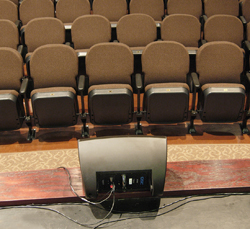Front fill loudspeakers are required in many sound reinforcement situations because the main loudspeakers don’t cover the first few rows of seats, and in some productions, they’re also used because the mains (often far above the seats or positioned to the sides) result in skewed localization.
Another less frequently encountered need is to correct the mix balance as heard from the front rows, primarily in musical theater.
Even very well-designed, pattern-controlled loudspeakers, clusters, and arrays lose pattern control at middle and low frequencies, so if we attempt to cover the front rows with higher frequency energy from the loudspeakers above, we can end up washing the front of the stage or platform with (uncontrolled) middle and low frequency energy.
This results in muddy sound on the stage (which may force stage monitor levels up) plus increased potential for feedback from the front line microphones.
It’s also often the case that the loudspeakers we own (sound departments, rental companies) or which we have selected for other specific reasons (installed systems) simply do not cover from the front to rear rows, or they do, but with significant overlap or projecting sound onto ceiling surfaces.
Other factors which dictate where we locate the primary loudspeakers (and therefore impact how they cover) include architect/event planner/client influence (appearance) and structural needs.
Finally, on rock n’ roll stages (clubs, larger spaces and outdoors), the stage monitor and back line volume levels may, at times, be so loud (due to musician demands) that even if we have complete coverage from the primary loudspeakers, the quality of the mix heard directly in front of the stage has taken a severe hit. This problem is also present in many churches employing louder contemporary worship and/or modern gospel music.
Location, Location
For theatrical sound where the primary loudspeakers cover to the edge of the stage, those seated in the front rows have the experience of seeing the actors directly ahead but hearing their voices coming distinctly from above. Transparency takes a big hit!
There can also be audible comb filtering if the acoustic source and the reinforced sound from the loudspeakers are near equal in level because of the difference in their arrival times (location disparity). The need to prevent these distortions also occur in other events such as worship spaces and corporate work.
In these situations, we employ front fill loudspeakers that can be laid across the stage lip/apron, attached via yoke mounts (to stage or pit rail) or propped up in front of the stage. Often they must be visually masked or completely concealed. Front fills should be mounted as low as possible (for sight lines), but their depth of coverage is compromised when mounted too low.















